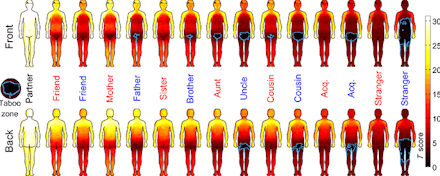One Map Shows Where It's OK to Touch People (And Where It Isn't)

If you've ever wondered "Is it ever okay to slap my best friend's ass?" or "Is it all right to lightly tap my co-worker's penis as a form of polite greeting?" then, well, you should probably consult your co-worker and your best friend for a definitive rundown of exactly what they're comfortable with. But if you'd like a reference point indicating what society generally deems appropriate, don't worry: There's an infographic for that.
A recent study has determined which parts of the body are most universally accepted as "touchable" by various members of one's social circle, as well as which body parts are off-limits. The "bodily map" is organized by relationship type and gender. Basically, the darker the area, the more likely it will be considered taboo to touch that particular person there.
The map is based on research that comes out of Aalto University in Finland and the University of Oxford in the United Kingdom. Lead researcher Juulia Suvilehto and her team surveyed a diverse sample of 1,368 people from all across Europe (Finland, France, Italy, Russia and the United Kingdom). The participants were all shown silhouettes of bodies, each with the above relationship labels ("cousin," "stranger," acquaintance," etc.), and then asked to indicate where on their own bodies they would allow that particular person to touch them.
Some of the results aren't particularly surprising: For instance, genitals tend to be fairly off-limits for pretty much anyone but an intimate partner (apologies to anyone who was like, "Yes!" to the co-worker-penis-tap example above).
But the study does have valuable implications for those interested in studying human communication in general. Suvilehto told Mic that the goal of the study was to learn more about the mysterious ways that humans send each other nonverbal messages, even when they're total strangers.
"Social touch is a very important, and very intimate form of communication, but one that we do not know all that much about," she said. "We wanted to create a baseline knowledge on how people use social touch in their social network, so that we could better understand this process and the problems that occur."
Ultimately, the study found that touch is "an important mechanism that people use to maintain and establish social relationships, even more so than we originally expected to see," Suvilehto told Mic. Somewhat surprisingly, the study's results were pretty much the same across all cultures, indicating that our idea of what does and doesn't constitute appropriate touch "might be biologically driven ('natural') behavior with only minor impact from culture."
Of course, when it comes to certain kinds of touch, there is no substitute for actual, verbal communication; for instance, while the map shows that people are comfortable with their romantic partners touching most parts of their body, it goes without saying that you need to obtain clear affirmative consent before you venture anywhere near their bathing suit parts.
That said, the social touch study shines a light on how people generally perceive the appropriateness of touching across various social dynamics. It also reaffirms the importance of body language and nonverbal interactions in establishing a social relationship: Past research has also concluded that social touch, whether it's a pat on the shoulder from a sympathetic friend or a high-five from a colleague, can serve as a powerful bonding mechanism.
When you consider that touching can sometimes create confusion or embarrassment in certain situations, the resulting graphic could prove to be useful. Who could forget the Friends episode where Chandler's boss wouldn't stop slapping his ass? If only he had a copy of this handy reference chart to give to his boss, Mr. Bing could have saved himself from a lot of unacceptable tushy-touching.